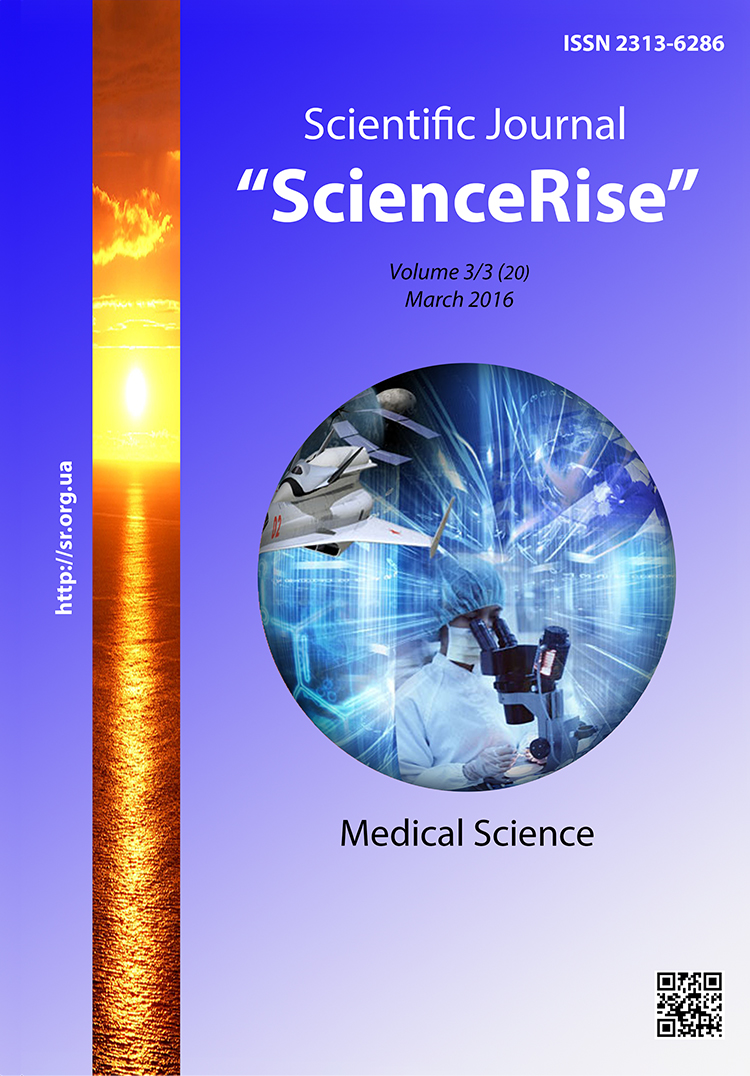The state of immunological reactivity and nonspecific protection factor (lysozyme) in children with reactive arthritis
DOI:
https://doi.org/10.15587/2313-8416.2016.64834Keywords:
reactive arthritis, children, cellular and humoral immunity, cytokines, secretory immunoglobulin A, lysozymeAbstract
Aim. An improvement of diagnostics and prognostication of ReA clinical course in children on the base of studying the immunological reactivity and non-specific protection factor (lysozyme).
Materials and methods. Examination of children took place in the municipal children’s cardiorheumatologic department of MHPI “Kharkov municipal children’s clinical hospital № 24" and municipal children’s polyclinic of the Kharkov city (№ 1, 2, 7, 12, 13, 14, 23).
40 children with ReA underwent immunological examinations, detection of sIgA in the saliva and lysozyme in the blood serum in acute period and in 9–12 months after the beginning of disease. 19 children (47,5 %) – 2–6 years old, 21 children (52,5 %). – 7–14 years old. Boys – 22 (55,0 %), girls – 18 (45,0 %). The mean age of children in group was 7,2±0,32. The control group included 32 healthy children. The mean age of children in group was 7,4±0,54.
The ReA diagnosis was set according to the order of Ukrainian MHP of 19.07.2005 № 362 “Protocol of diagnostics and treatment of disease of musculoskeletal system and connective tissue in children ICD-D М00-М25 arthropathies”.
Immunological examinations included the study of indices of cellular, humoral, monocytic-phagocytic links of immunity, content of cytokines (IL-1β, IL-6), detection of sIgA and index of nonspecific protection factor (lysozyme).
Assessment of results of researches was carried out using STATISTICА program for Windows (version 10.0), Microsoft Excel 2012, MATLAB 2015a.
Results. In the ReA acute period in children was observed depression of T-system on the background of activation of immunity B-system as the reliable decrease of СD8, СD25 and increase of СD21. There was revealed an increase of IL-6, increase of phagocytic number, spontaneous NBT-test and spontaneous neutrophils activity index.
The sIgA level reliably exceeded the standard. At determination of lysozyme the blood serum of patients with ReA in acute period was revealed its deficiency comparing with the standard.
In 9–12 months after the beginning of disease in subgroup of children with prolonged and relapsing clinical course was preserved the increase of IL-6 level and decrease of CD8, CD25 and increase of CD21, increase of sIgA and low content of lysozyme. The indicators of the favorable ReA outcome (remission) are: normalization of indices of T- and B-cellular link of immunity, IL-6, sIgA and lysozyme.
Conclusions.
1. In the ReA acute period was detected the decrease of CD8, CD25, increase of CD21and IL-6. The phagocytic link of immunity functions in the hypercompensation mode with emaciation (decompensation) phenomena. The sIgA content is increased and lysozyme level is decreased.
2. In 9–12 months after the beginning of disease in subgroup of children with remission was detected normalization of indices of T- and B-cellular links of immunity IL-6, sIgA and lysozyme. In subgroup of children with prolonged and relapsing clinical course was preserved increase of CD21, IL-6, sIgA and decrease of CD8, CD25 and lysozyme
References
Natal'chenko, G. I. (2011). Jetiopatogenez, klinika, diagnostika reaktivnyh artritov u detej: (obzor literatury). Perinatologija i pediatrija, Issue 2, 110–112.
Omel'chenko, L. I., Oshljanskaja, E. A. (2010). Aktual'nye voprosy vtorichnoj profilaktiki sustavnogo sindroma u detej. Sovremennaja pediatrija, 1, 43–47.
Marushko, T. V. (2012). Reaktyvni artropatii' u ditej. Zdorov’ja Ukrai'ny, 2, 43–44.
Berezhnyj, V. V., Marushko, T. V., Marushko, Ju. V. (2009). Klinichna revmatologija dytjachogo viku. Cherkasy: v-c' Chabatenko Ju., 192.
Kim, P. S., Klausmeier, T. L., Orr, D. P. (2009). Reactive Arthritis: A Review. Journal of Adolescent Health, 44 (4), 309–315. doi: 10.1016/j.jadohealth.2008.12.007
Rihl, M., Klos, A., Köhler, L., Kuipers, J. G. (2006). Reactive arthritis. Best Practice & Research Clinical Rheumatology, 20 (6), 1119–1137. doi: 10.1016/j.berh.2006.08.008
Selmi, C., Gershwin, M. E. (2014). Diagnosis and classification of reactive arthritis. Autoimmunity Reviews, 13 (4-5), 546–549. doi: 10.1016/j.autrev.2014.01.005
Spas'ka, G. O. (2011). Reaktyvnyj artryt: suchasnyj pogljad na problemu. Ukrai'ns'kyj medychnyj chasopys, 6, 42–48.
Gaponova, T. V., Lila, A. M., Shemerovskaja, T. G. et. al (2008). Izuchenie citokinovogo statusa bol'nyh reaktivnym artritom. Medicinskaja immunologija, 2-3, 167–172.
Chaplygina, L. N. (2007). Kliniko-diagnosticheskoe znachenie laktoferrina i molekul citokinov u bol'nyh reaktivnymi artritami. Jaroslavl’, 142.
Lebec', I. S., Pan'ko, N. O., Nelina, I. M. (2014). Harakterystyka imunologichnyh zmin na riznyh etapah rozvytku juvenil'nogo revmatoi'dnogo ta reaktyvnogo artrytiv u ditej. Perynatologyja y pedyatryja, 2, 64–67.
Brjazgunov, I. P. (2008). Dlitel'nye subfebrilitety u detej (klinika, jetiologija, patogenez i lechenie). Moscow: OOO «Medicinskoe informacionnoe agentstvo», 240.
Julish, E. I. (2010). Faktory mestnogo immuniteta pri respiratornyh infekcijah i metody ih aktivacii. Zdorov'e rebenka, 5, 77–83.
Downloads
Published
Issue
Section
License
Copyright (c) 2016 Tat'jana Tverdohleb, Vladimir Savvo

This work is licensed under a Creative Commons Attribution 4.0 International License.
Our journal abides by the Creative Commons CC BY copyright rights and permissions for open access journals.
Authors, who are published in this journal, agree to the following conditions:
1. The authors reserve the right to authorship of the work and pass the first publication right of this work to the journal under the terms of a Creative Commons CC BY, which allows others to freely distribute the published research with the obligatory reference to the authors of the original work and the first publication of the work in this journal.
2. The authors have the right to conclude separate supplement agreements that relate to non-exclusive work distribution in the form in which it has been published by the journal (for example, to upload the work to the online storage of the journal or publish it as part of a monograph), provided that the reference to the first publication of the work in this journal is included.

